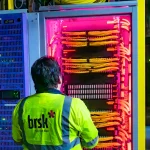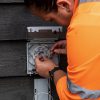SpaceX Successfully Launch First 60 LEO Ultrafast Broadband Satellites
SpaceX has this morning completed the first successful launch and delivery of 60 small Starlink Satellites, which are Low Earth Orbit (LEO) dwelling spacecraft that could in theory deliver “ultrafast broadband” speeds of up to 1Gbps and low latency times of around 25ms (milliseconds) around the world. Many more will follow.
Last year the company launched two test satellites – Microsat-2a and Microsat-2b (here) – on the back of their two-stage 70 metre high Falcon 9 rocket, which each measured just 1.1m x 0.7m x 0.7m with a mass of 400kg. By comparison the final flat-panel design for Starlink 1 – 60 has reduced the individual weight (mass) to just 227kg, featuring a single solar panel. The satellites are stacked (like an old CD storage rack) on top of a single rocket.
Interestingly we understand that most of the initial Starlinks (75 or so) are still considered prototypes (aka – Block v0.9) and will thus not feature optical inter-satellite links (essential for the eventual constellation to work properly), which means we’re technically into what passes in space for a live field-trial of the new network (i.e. testing deployment, network operation and de-orbiting features).
Advertisement
According to Elon Musk, “Much will likely go wrong on 1st mission. Also, 6 more launches of 60 satellites needed for minor coverage, 12 for moderate.” The first 1,584 Starlink satellites are expected to operate from a 550km orbit (GSO / GEO Stationary Orbit satellites sit at about 35,000km+ and are often more akin to the size of a double decker bus). Later sub-constellations are planned for 1,200km and the very low 340km orbital altitude, bringing the final constellation size to nearly 12,000 satellites.
 SpaceX has often boasted that their LEOs could offer “affordable … fiber-like speeds” of up to 1Gbps (here) and the lower altitude will also afford them latency times that are closer to a good fixed line broadband or 4G mobile connection (figures between 15 and 35 milliseconds have been stated). By comparison big GSO satellites tend to suffer from horrifically slow latency times of 600ms+ and capacity strain (slower speeds, especially at peak times).
SpaceX has often boasted that their LEOs could offer “affordable … fiber-like speeds” of up to 1Gbps (here) and the lower altitude will also afford them latency times that are closer to a good fixed line broadband or 4G mobile connection (figures between 15 and 35 milliseconds have been stated). By comparison big GSO satellites tend to suffer from horrifically slow latency times of 600ms+ and capacity strain (slower speeds, especially at peak times).
In this setup end-users would need to install “relatively small” flat panel terminals (the size of a laptop) on their homes, which will use phased array technologies to allow for highly directive, steered antenna beams. The first customers could then be live by mid-2020 (c.800 satellites should be ready by then), long before the full rollout is completed several years later.
The new solution would be ideal for tackling digitally disadvantage parts of our world (e.g. remote rural parts of the UK), although creating such a huge network of many small spacecraft will not be easy (note: each LEO platform could handle an aggregate download capacity of up to 23Gbps).
Advertisement
SpaceX has strong competition in the LEO market from rival OneWeb (here) and a couple of other operators, not to mention existing GSO providers like ViaSat, Eutelsat, Avanti and so forth. However if the new LEO networks work as planned then it’s hard to see how GSO based broadband ISPs will be able to compete. Time will tell as we haven’t yet seen the first package details or benchmarks.
Aside from the sheer complexity of managing such a huge constellation of spacecraft (tricky to avoid breaks in data coverage), there are also on-going concerns about the rising levels of “space junk” in orbit. Ensuring that all of these new LEOs decay out of orbit correctly so that they don’t add to the growing problem will be part of SpaceX’s initial testing (i.e. we think some of the first Starlinks are sacrificial).
Mark is a professional technology writer, IT consultant and computer engineer from Dorset (England), he also founded ISPreview in 1999 and enjoys analysing the latest telecoms and broadband developments. Find me on X (Twitter), Mastodon, Facebook, BlueSky, Threads.net and Linkedin.
« B4RN Cheshire Set to Begin Primary 1Gbps FTTH Broadband Rollout

















































Comments are closed